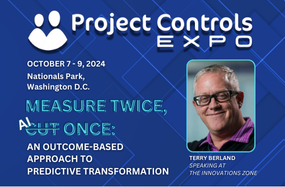
5 Best Practices for Utility Capital Planning & Execution

Contributed by InVizion LLC
Optimizing a Capital Improvement Program (CIP) can be a daunting task for any organization given the inherent complexities and many “moving parts” that constitute the plan. When a CIP comprises a hundred or more projects, juggling the budgets, timelines and resources – all of which are limited or constrained – presents huge challenges for those responsible.
Although we start with the best intentions including a well thought out financial plan, a prioritized list of projects and their justification, along with a detailed construction (and maintenance) schedule, things seldom go according to the plan.
During a typical program execution year, multiple iterations of adjustment and recalibration of the initial plan are critical to maintain and balance the overall goals and objectives of the key stakeholders. Conscientious planners and analysts must be able to rapidly model competing priorities, demands and constraints and then evaluate and clearly present optimal scenarios to executives for budget, timeline, resource re-allocation or other changes.
Here are 5 tips to assist with the planning and execution of a CIP…
- Enhance Modeling Capabilities
Understanding cause and effect, along with its more insidious cousin – unintended consequences – presents a challenge for planning and executing programs. Planners and analysts are tasked with creating budgets and programs that are accurate and dynamic. But, it’s the inflexible, disconnected financial systems and reams of standalone spreadsheets, that challenge them. Manually modeling the various drivers and their varying degrees of cascading impacts is daunting, especially with daily and weekly operational changes. Without the right solution to easily model cause and effect, strategic financial decisions, and day-to-day operational issues, are all too often made on gut-feel, outdated or erroneous data. Empowering key decision-makers by helping them quickly find answers to statistical and predictive questions via reliable cloud-based BI platforms empowers analysts to create mashup data in realtime.
- Increase Interdependence Visibility
Programs are a collection of projects and as part of a capital plan they are all tied together. Some have weaker links than others but, by definition, a CIP pulls everything together and creates ties between budgets, resources, regulatory milestones, etc. Therefore, the effectiveness of most projects and investments is dependent on the successful completion of other projects or investments. These logical interdependencies among investments or projects need to be tracked and accurately reflected. The downside is when interdependencies are missing in budget models, decisions get made as if projects and investments are completely autonomous and independent. For example, shutting down part of a facility to install new equipment without fully understanding the broader ramifications – and ties to – other projects could result in everything from increased costs, to regulatory violations to lowered customer satisfaction. More broadly, ignoring interdependencies can result in unrealistic ROI expectations, higher risks, and increased life cycle costs. An integrated system adds value to the business by handing off information from one business function to another.
- Reduce Manual Processes
We accept error-prone processes when using spreadsheets and other manual techniques for planning. That’s why the most conscientious planners and analysts end up spending inordinate amounts of time manipulating macro-infested spreadsheets, chasing-down formulas among cells on dozens of related worksheets and hoping that the lookup tables used aren’t erroneous. This is no way to run an organization. Yet, it can all be reduced through solutions designed to take this archaic, manual, repetitive and mistake-laden process and automate it. Even when a project is done, archiving data manually can be incredibly time-consuming. Manual archiving can take up to 4 times the amount of time as automated archiving – per project! Ideally, this process should be an automatic process to avoid any manual errors or omissions. The benefit is, naturally, less mistakes, lower costs and greater efficiency. But the biggest gain could be in understanding and insights. With all this manual manipulation a thing of the past, there’s valuable time and added brainpower to perform accurate and reliable analysis to unearth new opportunities.
- Ask More Questions
“What if?” Children have a distinct ability to ask this very simple – yet powerful – question. Certainly, we could learn from them. Our questions, either “what if” or “what are”, etc. will be more complex and have interdependent variables and constraints but, ultimately, we need to ask this question. What are the best investments to be made with available capital to accomplish our objectives? What are some different options to adjust the budget roadmap or spend plans in order to be as close to target as possible without going over? What if my projects were in the Cloud? Will they perform better, faster? Planners and analysts need to compare multiple “what-if” scenarios to evaluate each scenario’s impact on costs, risks, goals, and objectives. Without these scenario comparisons, how can someone objectively demonstrate that the optimal scenarios are being recommended—the ones most aligned with objectives and constraints—while reducing uncertainty and increasing confidence of business decisions? The right questions coupled with the right technology solution can uncover hidden opportunities and alternate options that may not have surfaced or be seen as feasible. A specialist in projects has knowledge to provide streamlined processes to empower better decision-making that can help ensure project schedules are on time and cost estimates stay on budget.
- Collaborate Consistently
One of the softer planning skills – e.g., beyond analysis and scenario modeling – is the ability to collaborate. Even after you have completed a sufficient “what-if” analysis and identified an optimal budget plan, it would be a mistake to just “throw it over the wall” to the performing stakeholder groups. To realize a successful outcome, key stakeholders need to be engaged and empowered early-on to recognize the optimal alternatives and throughout the process to ensure alignment and agreement to execute the plan (or the change to the program, project, etc.) You can achieve even greater success with a reliable project management cloud service, enabling full scale collaboration. By combining an effective, objective, and collaborative budgeting process with scalable, secure and connected cloud-hosted project management solutions, an organization can speed its way to the best business outcomes.
Want to know more about LOADSPRING can help you execute these best practices? Call us at +1 978.685.9715 or send us your questions here.








